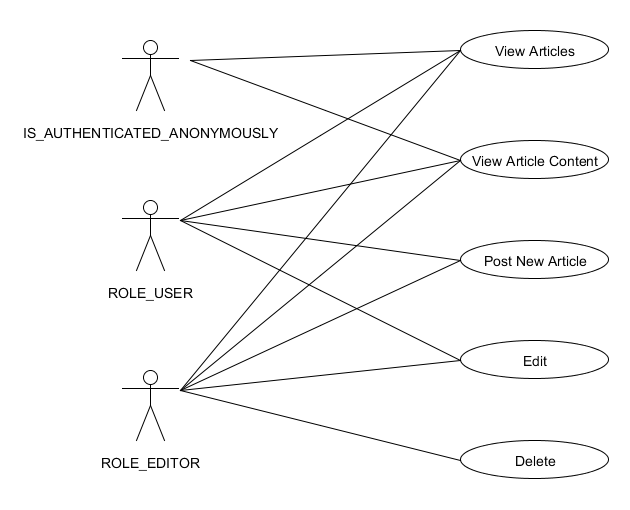Integrate Spring Security with ZK"
| Line 109: | Line 109: | ||
<intercept-url pattern="/newArticle.zul" access="ROLE_USER" requires-channel="https" /> | <intercept-url pattern="/newArticle.zul" access="ROLE_USER" requires-channel="https" /> | ||
</source> | </source> | ||
| − | Here the ''pattern'' attribute is to determine | + | Here the ''pattern'' attribute is to determine which request this setting will take effect, and if a request's URL matches this pattern, |
| − | the ''access'' attribute will be used to check current user's authorities | + | the ''access'' attribute will be used to check current user's authorities. |
=Login Page Implementation in ZK= | =Login Page Implementation in ZK= | ||
Revision as of 09:08, 26 February 2013
Ian Tsai, Engineer, Potix Corporation
March 04, 2013
ZK 6.5.X, Spring Security 3.1.2
Introduction
Spring Security is a common solution for developer to serve security needs in a Java web application, it is widely used and is a proven technology. However, due to its nature to protect resources by pattern matching through URL, it's not that obvious for application developer to delegate Spring Security with general amount of ajax frameworks which use Json format in form to structure meta-information.
So in this article, I'll introduce how to integrate Spring Security with ZK seamlessly by going through the construction of a simple demo application(An article publish and editing system).
Resources to Download
I use Git as my source control and has stored my code at Github, you can check out the demo project from here.
If you are more comfortable to war format, you can get the archived project here.
The project is based on Maven, if you want to try different version of ZK or Spring, please change the version number in pom.xml
Demo Application Details
This demo application is a simple article publish and edit system which allows three kinds of user to access: user with role ROLE_USER, user with role ROLE_EDITOR and the anonymous user with default reserved role IS_AUTHENTICATED_ANONYMOUSLY.
- Anonymous user can visit the homepage which contains article list, and they can view an article's content by clicking it's link in homepage.
- User with role ROLE_USER is allowed to post new article and edit their own articles.
- User with role ROLE_EDITOR is most powerful user who is able to edit and delete any article.
This article will based on the implementation requirements of this application to demonstrate the integration of Spring Security and ZK.
Spring Security Configuration
First, let's see how to configure our project. To use Spring Security, we have to add some listener and filter declarations in web.xml:
<context-param>
<param-name>contextConfigLocation</param-name>
<param-value>
/WEB-INF/applicationContext.xml
/WEB-INF/applicationContext-security.xml
</param-value>
</context-param>
<listener>
<listener-class>org.springframework.web.context.ContextLoaderListener</listener-class>
</listener>
<listener>
<listener-class>org.springframework.web.context.request.RequestContextListener</listener-class>
</listener>
<listener>
<listener-class>org.springframework.security.web.session.HttpSessionEventPublisher</listener-class>
</listener>
<filter><!-- the filter-name must be preserved, do not change it! -->
<filter-name>springSecurityFilterChain</filter-name>
<filter-class>org.springframework.web.filter.DelegatingFilterProxy</filter-class>
</filter>
<filter-mapping>
<filter-name>springSecurityFilterChain</filter-name>
<url-pattern>/*</url-pattern>
</filter-mapping>
As you can see, despite those ordinary Spring Context Listeners(RequestContextListener and ContextLoaderListener), we declared HttpSessionEventPublisher and springSecurityFilterChain for Spring Security. Here the HttpSessionEventPublisher is optional and it is designed for Spring Security to do detailed concurrent session control, the springSecurityFilterChain is the main hook for all Spring Security's functionality to the application, it's required and must be named springSecurityFilterChain.
applicationContext-security.xml
Here in this project, I separated Spring's ApplicationContext.xml to two files, the original ApplicationContext.xml is for backend bean and sevice bean declarations, and the additional applicationContext-security.xml is for Spring Security's configuration only.
In applicationContext-security.xml, there are two major elements we have to setup, the <http> element and the <authentication-manager> element.
Http Element Setting
The <http> element is to tell Spring what kind of resources need to be secured, which port will be used by container for http & https connections, and what kind of log-in solution will be used in this web application.
<http auto-config="true">
<port-mappings>
<port-mapping http="8080" https="8443"/>
</port-mappings>
<intercept-url pattern="/zkau/**" access="IS_AUTHENTICATED_ANONYMOUSLY" requires-channel="any"/>
<intercept-url pattern="/login.zul" access="IS_AUTHENTICATED_ANONYMOUSLY" requires-channel="https" />
<intercept-url pattern="/newArticle.zul" access="ROLE_USER" requires-channel="https" />
<intercept-url pattern="/j_spring_security_check" access="IS_AUTHENTICATED_ANONYMOUSLY" requires-channel="https" />
<intercept-url pattern="/**" access="IS_AUTHENTICATED_ANONYMOUSLY" requires-channel="any" />
<session-management session-fixation-protection="none" />
<form-login login-page="/login.zul"
authentication-failure-url="/login.zul?login_error=1"
login-processing-url="/j_spring_security_check"/>
<logout logout-success-url="/index.zul" invalidate-session="true" />
</http>
Authentication Manager Setting
The <authentication-manager> element declaration is designed to manage authentication-provider which is the provider of Spring's authentication instance and will do the real work of the authentication. You can declare multiple authentication-providers in order to leverage different source of users(ex: openidAuthenProvider or LDAPAuthenProvider), in this project we extends UserDetailsService from default authentication-provider:
<authentication-manager>
<authentication-provider user-service-ref="myUserDetailsService">
<password-encoder hash="md5" />
</authentication-provider>
</authentication-manager>
<beans:bean id="myUserDetailsService"
class="org.zkoss.demo.springsec.model.MyUserDetailsService"/>
Protecting a Page Request
After the configuration of Spring Security, now, let's see how to use it to protect a zul file request.
Scenario: When User requesting a restricted resource
In our demo project, NewArticle.zul is a restricted resource that can only be accessed by user who already logged in, it's natural because to post a new article, we have to know who is the author.
In Spring Security, to restrict a resource for certain user( who has enough permission) to access is very simple, we simply declare <intercept-url> element under <http> in applicationContext-security.xml:
<intercept-url pattern="/newArticle.zul" access="ROLE_USER" requires-channel="https" />
Here the pattern attribute is to determine which request this setting will take effect, and if a request's URL matches this pattern, the access attribute will be used to check current user's authorities.
Login Page Implementation in ZK
Securing Partial View By Using EL in ZUL
ZK's Special Component Attributes for Security
Disable & Visible
ZK EE Sever-side Event Disablement Filtering
ZK Ajax Request Security Handling
Comments
| Copyright © Potix Corporation. This article is licensed under GNU Free Documentation License. |

